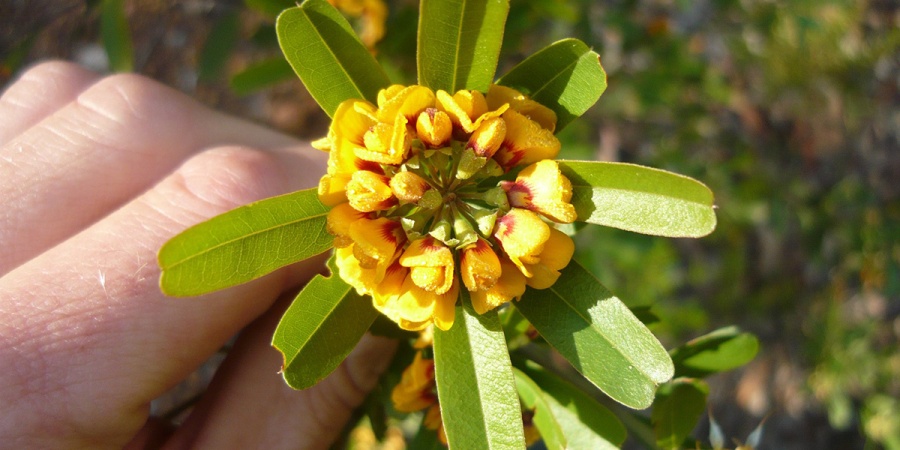
Heart leaf poison (Gastrolobium bilobum). Photo by DBCA
What is 1080?
1080 is a synthetic version of sodium fluoroacetate, which occurs naturally in the Gastrolobium genus (native 'pea plants'). This provides Western Australia with an advantage in managing introduced predators. Approximately 40 species of native plants in Western Australia, primarily found in the south-west of the state, produce the toxin as a defence mechanism against being eaten.
Native animals that have co-evolved with these toxic plants have developed varying tolerance levels to the toxin. However, introduced animals such as foxes, rabbits, dogs, and pigs are highly susceptible to 1080 since they have not had long-term evolutionary exposure to it.
Why does DBCA use baiting?
The presence of invasive species has consistently been identified as one of the most significant threats to WA’s native species and ecosystems. Predation by foxes and feral cats is a leading cause of the decline and extinction of many native animals in Australia. Managing feral predators such as foxes and feral cats is critical to ensure the survival and recovery of native fauna in WA.
The department has used baiting since 1977 after research demonstrated that fox populations could be successfully managed using 1080 baiting. This program expanded and became known as Western Shield in 1996.
Over the past decade, the impact of feral cat predation has become more apparent, with populations of some threatened species declining, such as the woylie, numbat, and black-flanked rock wallaby, despite the success of fox baiting. To address this issue, Western Shield is integrating DBCA’s feral cat bait with fox baiting to reduce the impact of feral cats on native fauna.
What types of baits are used?
To optimise uptake, two different bait products have been developed for foxes and feral cats.
Probait® are salami-like sausages injected with 1080, which are dried to make them hard and less palatable to native animals, although they are attractive to foxes.
Cats prefer live prey, so they do not normally eat the dried meat baits used for controlling foxes. DBCA has developed smaller, moister 1080 sausage baits that are more appetising to feral cats, called Eradicat®.
1080 breaks down quickly in the soil without any environmental side effects. All 1080 products used by DBCA have been approved for use by the Australian Pesticides and Veterinary Medicines Authority and are used according to the label or research permit requirements and the Department of Health's Code of Practice for the safe use and management of registered pesticides containing 1080, PAPP and strychnine.
How are baiting locations decided?
A prioritisation process considers the conservation status of key native fauna species, distribution, vulnerability to introduced predators and the likelihood of recovery with introduced predator control. This process and site feasibility criteria inform the priority areas for baiting.
View fox and feral cat 1080 baiting locations in Western Australia.
When are baits laid?
Baiting activities, as well as other management options, are carefully timed. Eradicat® is laid when prey is scarce, so feral cats are more likely to eat the bait. Probait® is used year-round to control foxes. Baits are distributed aerially and from the ground by specially trained staff and contractors. Areas subject to baiting by the Parks and Wildlife Service should always be considered unsafe for domestic pets.
How are the baits distributed?
Most 1080 baiting is done aerially, as this is the most effective way to cover large areas. Aerial fox baiting is carried out multiple times a year across around 3.8 million hectares.
Feral cat baiting occurs once a year, using a specially modified aircraft. This can drop baits with great precision. The baiting aircraft can drop five fox baits per square kilometre (or one bait for every 20 hectares) and 50 feral cat baits per square kilometre (or 10 baits for every 20 hectares).
Ground baiting is also undertaken for more targeted control of foxes and feral cats, and in smaller, more isolated reserves (usually once a month), or in areas with highly sensitive species. Recurring baiting is necessary as foxes from surrounding unbaited areas can quickly return to these sites.
More information
For more information about 1080 for landholders controlling foxes and feral cats on their property, visit the Department of Primary Industries and Regional Development website.
1080 is considered to be the most environmentally responsible option currently available. Many native fauna species are tolerant to the toxin, it is highly soluble and biodegrades relatively quickly, and application can be target-specific. Learn more about 1080 on the PestSmart website.
